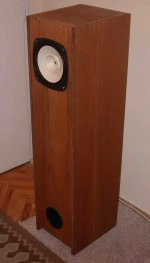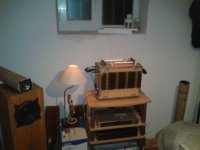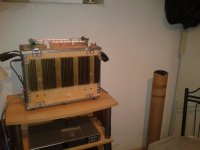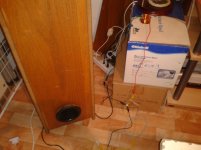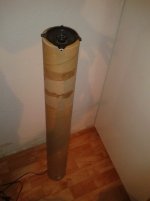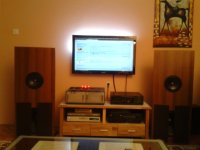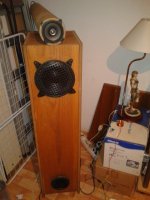Hi,
As I am using open baffle as a main system (see last pic), some of the past projects, some still working, some scrapped, ended half way between the living room and the trash bin..they reside in the "man cave", i.e., basement. While I was doing some tidying of the basement, it occurred to me that I have just enough parts , that, put together, can make a nice test rig, without disturbing others...
One of the things that always intrigued me was a FAST loudspeaker system, but I wasn't quite prepared to spend cash, partly because I am still happy with the Open baffle and associated electronics while it is still allowed in the living room .
.
So, the basement components gave a good ground to try some things out, just for fun of it...
The amp that you see on top is a S.E.W.A amp, with halogen sticks as a current source.
http://www.diyaudio.com/forums/pass-labs/66822-sewa-seven-watt-amplifier.html
Below is the preamp, Pass labs Bride of Zen preamp, and the old CD player...
Bass speakers enclosure is a "leftover" from my previous speakers M.J. King ML-TL with Fostex 206.... (see pic) .
Fostex is no longer there, but the enclosure was still in the basement, so I bought some cheap 8" drivers. No parameters available, neither I was ready to spend time measuring. Just quick'n dirty pop em' there. Crossover is comprised of a single air coil, must have somewhere around 2.5 mH....
For the top, I used some 4" Sony car speakers mounted in a cardboard tube (being an omni in the sort of ML-TL's -worked quite nice by themselves in the office until my boss ordered their removal). Now I relieved them from the bottom end, by a series cap. Tried values from 68-100 uF (this is a 4 ohm speaker).
I was truly surprised at how good such a (s)crap system can sound...
These days I am planning to do some more experimenting with various FR's on top, in various boxes (or no boxes)....
As I am using open baffle as a main system (see last pic), some of the past projects, some still working, some scrapped, ended half way between the living room and the trash bin..they reside in the "man cave", i.e., basement. While I was doing some tidying of the basement, it occurred to me that I have just enough parts , that, put together, can make a nice test rig, without disturbing others...
One of the things that always intrigued me was a FAST loudspeaker system, but I wasn't quite prepared to spend cash, partly because I am still happy with the Open baffle and associated electronics while it is still allowed in the living room
So, the basement components gave a good ground to try some things out, just for fun of it...
The amp that you see on top is a S.E.W.A amp, with halogen sticks as a current source.
http://www.diyaudio.com/forums/pass-labs/66822-sewa-seven-watt-amplifier.html
Below is the preamp, Pass labs Bride of Zen preamp, and the old CD player...
Bass speakers enclosure is a "leftover" from my previous speakers M.J. King ML-TL with Fostex 206.... (see pic) .
Fostex is no longer there, but the enclosure was still in the basement, so I bought some cheap 8" drivers. No parameters available, neither I was ready to spend time measuring. Just quick'n dirty pop em' there. Crossover is comprised of a single air coil, must have somewhere around 2.5 mH....
For the top, I used some 4" Sony car speakers mounted in a cardboard tube (being an omni in the sort of ML-TL's -worked quite nice by themselves in the office until my boss ordered their removal). Now I relieved them from the bottom end, by a series cap. Tried values from 68-100 uF (this is a 4 ohm speaker).
I was truly surprised at how good such a (s)crap system can sound...
These days I am planning to do some more experimenting with various FR's on top, in various boxes (or no boxes)....
Attachments
I'm continually surprised that the FAST system gets so little attention - there is such an ease to get really good results this way, particularly with the availability of reasonably priced good quality amplifiers to use as high pass and low pass amps with passive or the active electronic Xovers.
Moreover, tuens out that a decent 8" midwoofer in an ML-TL can go low enough. On the other hand, it has enough span to be crossed at around 400-500 hz first order. At such xo frequency, one can mount a fullrange of choice, without the need to do bass frequencies. When even such crappy speakers can manage to sound good, I can only imagine how would some nice 8" Peerles driver in an properly designed ML-TL do, with an Alpair 7.3 on top...
I'm continually surprised that the FAST system gets so little attention - there is such an ease to get really good results this way, particularly with the availability of reasonably priced good quality amplifiers to use as high pass and low pass amps with passive or the active electronic Xovers.
Yeah, this is what the pioneers of audio deemed a good use of wide BW drivers once the source material had enough BW to justify more than one driver, or speaker, if the original was a large horn.
I've been touting them as long as I've been on line, but as you noted, it's only been recently with the advent of low noise DSP, chip amps that folks have begun to embrace them.
GM
Moreover, tuens out that a decent 8" midwoofer in an ML-TL can go low enough. On the other hand, it has enough span to be crossed at around 400-500 hz first order. At such xo frequency, one can mount a fullrange of choice, without the need to do bass frequencies. When even such crappy speakers can manage to sound good, I can only imagine how would some nice 8" Peerles driver in an properly designed ML-TL do, with an Alpair 7.3 on top...
Correct, all my early TL, tower [MLTL] speakers for others were 8"-12" wide BW drivers mated to 2"-4" paper [mid]tweeters 'rescued' from old radios, consoles, TVs with them hooked the same as originally, i.e. the woofer run full range and just a cap on the HF, with 2.2 uF being the most common. Even did a few 15" variants for party apps.
I seriously doubt such simple designs would pass muster with today's much more discerning DIYer, but to the '60s-'70s youngsters they did AM/FM, vinyl, eight track tape and even Quadraphonic just fine, thank you very much
GM
I did some more testing and playing with cheap drivers..definitely a concept worth pursuing and doing properly, with "real" drivers...
Here's a link with some photos (along with some other DIY projects)...
https://www.dropbox.com/sh/zuqip6428gh1m6s/Sgs_77A7l0#/
Here's a link with some photos (along with some other DIY projects)...
https://www.dropbox.com/sh/zuqip6428gh1m6s/Sgs_77A7l0#/
The FAST system is all about using a really good driver/amp combination specifically for bass and the FR driver/amp selected for the tonal balance to suit your own personal taste & music.
The Xover point for the Fast is about 120 - 150Hz so it isn't just another 2way speaker system - by it's designation, it simple removes the difficult job for the FR driver to try to reproduce the bass freqs.
There have been quite a few very successful matched Fast systems over the years and a search will show the benefits & difficulties of most of the selections - unfortunately, there is a certain ignorance about the combination of amplifier/driver benefits but the best results seem to be when the bass driver efficiency matches that of the FR driver so this usually precludes the use of the smaller dia bass drivers even with DSP freq assistance - it's hard enough to get the Linkwitz Transform/B2 alignment working "properly"
There are quite a few High efficiency FR drivers now on the retail market at quite resonable prices - I suggest you purchase good quality drivers, even when just trying the idea out as you can always onsell good drivers if not suitable.
The Xover point for the Fast is about 120 - 150Hz so it isn't just another 2way speaker system - by it's designation, it simple removes the difficult job for the FR driver to try to reproduce the bass freqs.
There have been quite a few very successful matched Fast systems over the years and a search will show the benefits & difficulties of most of the selections - unfortunately, there is a certain ignorance about the combination of amplifier/driver benefits but the best results seem to be when the bass driver efficiency matches that of the FR driver so this usually precludes the use of the smaller dia bass drivers even with DSP freq assistance - it's hard enough to get the Linkwitz Transform/B2 alignment working "properly"
There are quite a few High efficiency FR drivers now on the retail market at quite resonable prices - I suggest you purchase good quality drivers, even when just trying the idea out as you can always onsell good drivers if not suitable.
JH,
You're right about FAST - if properly set up can punch way above its weight class in terms of money spent and effort put in. I think what puts lof of people off is:
1. 2nd amp - what to buy? If you are driving subs definitely something with watts. I've found cheap Class D very handy
2. XO - how and with what - this is a major one IMHO.I've done with Foobar ASIO plug-in, but then that setting does not work for other Windows programs, right...? Maybe MiniDSP can be a quick and easy solution here? Then comes XO frequency....
3. Driver matching, building a sub - there are many drivers/designs available - but again, more research and building. Another apprehension - will the sub be able to pla high enough for XO to be workable at desired SPL? Will the FR unit be able to play loud enough w/o distortion down to that XO level?
and building. Another apprehension - will the sub be able to pla high enough for XO to be workable at desired SPL? Will the FR unit be able to play loud enough w/o distortion down to that XO level?
Well helper "woofers" can be used too and should not have problems reaching higher XO frequencies vs subs.
You're right about FAST - if properly set up can punch way above its weight class in terms of money spent and effort put in. I think what puts lof of people off is:
1. 2nd amp - what to buy? If you are driving subs definitely something with watts. I've found cheap Class D very handy
2. XO - how and with what - this is a major one IMHO.I've done with Foobar ASIO plug-in, but then that setting does not work for other Windows programs, right...? Maybe MiniDSP can be a quick and easy solution here? Then comes XO frequency....
3. Driver matching, building a sub - there are many drivers/designs available - but again, more research
Well helper "woofers" can be used too and should not have problems reaching higher XO frequencies vs subs.
Last edited:
There is no question that FAST can produce an extremely good system. And at all levels of cost, from cheap to scary (ie the Feastrex/dual Audio Elegance OBs). XOs do not of necessity need to be active, althou given the component sizes of passive parts for an XO 100-400 Hz, there certainly is financial reason to take advantage of 2 amps. One of the most popular FASTs are variations on Martin Kings passive OB -- most people, i suspect, not even knowing they are building a FAST.
We keep exploring this nich, particularily with an eye to passive systems -- for some reason there is a big wall for some to consider active -- as we feel it offers the next of both worlds, and examples we have done to date certainly back that up.
dave
We keep exploring this nich, particularily with an eye to passive systems -- for some reason there is a big wall for some to consider active -- as we feel it offers the next of both worlds, and examples we have done to date certainly back that up.
dave
Yes, it is my main system for a few years now. There is a thread somewhere. Initially it started as Visaton no-box design, but it has evolved so it has almost nothing to do with that.
I will try to keep it short: Open baffle, 120x50 cm , no side wings, woofer is sort of slot-loaded.
Woofer: Eminence Beta 15. Fullrange: Visaton B200, modified (phase plug +Enabl). Biamped:
Woofer: Sony TA-N511 amplifier. Fullrange: DIY Pass labs F3 without feedback. Crossover: Active, j-fet diy, hi-pass at around 150 Hz second order, lo-pass 85 Hz with bass boost. TV: Samsung D503
Many thanks to those who helped me to understand Open baffles and provided useful (golden) hints. I must mention three names: MJK, NP, and ZM

I will try to keep it short: Open baffle, 120x50 cm , no side wings, woofer is sort of slot-loaded.
Woofer: Eminence Beta 15. Fullrange: Visaton B200, modified (phase plug +Enabl). Biamped:
Woofer: Sony TA-N511 amplifier. Fullrange: DIY Pass labs F3 without feedback. Crossover: Active, j-fet diy, hi-pass at around 150 Hz second order, lo-pass 85 Hz with bass boost. TV: Samsung D503
Many thanks to those who helped me to understand Open baffles and provided useful (golden) hints. I must mention three names: MJK, NP, and ZM

If there was no Open Baffle, I would do FAST for sure, it's real bang for a buck. Sometimes I go to the basement to listen to it, just for fun, and to remind myself that a good sounding system doesn't necessarily mean expensive...


JH,
You're right about FAST - if properly set up can punch way above its weight class in terms of money spent and effort put in. I think what puts lof of people off is:
1. 2nd amp - what to buy? If you are driving subs definitely something with watts. I've found cheap Class D very handy.
Right. Regardless of what you use on the bottom, the XO will be low enough that the bottom amp doesn't matter.
2. XO - how and with what - this is a major one IMHO.I've done with Foobar ASIO plug-in, but then that setting does not work for other Windows programs, right...? Maybe MiniDSP can be a quick and easy solution here? Then comes XO frequency....
Please stay away from the FB2K AISO plug-in. Use DS. The is absolutely no reason to screw with buggy ASIO drivers when DS works just fine. Unless your DAC won't work with DS (???), run, don't walk away.
miniDSP works just fine and is priced right. Do get the minDIGI to drive it with SP/DIF from your DAC.
You cross as low as you can without compromising the power/excursion rating of your top.
3. Driver matching, building a sub - there are many drivers/designs available - but again, more researchand building. Another apprehension - will the sub be able to pla high enough for XO to be workable at desired SPL? Will the FR unit be able to play loud enough w/o distortion down to that XO level?
Any competent 7-8" woofer will play plenty loud to keep up with a 3-4" FR. At the moment I'm looking at the Peerless 835026 and the Dayton RS-225-4. Now if you are only looking at buy-outs....
Well helper "woofers" can be used too and should not have problems reaching higher XO frequencies vs subs
This depends a lot on how you intend to use your FAST speakers. If for music only, the above two woofers will get you well into the 30's. If you are doing serious HT with action movies, you need BIG sub(s) to do justice to LFE.
Bob
Woofer: Eminence Beta 15. Fullrange: Visaton B200, modified (phase plug +Enabl). Biamped: hi-pass at around 150 Hz second order, lo-pass 85 Hz with bass boost.
Vix, that sounds like another FAST to me
dave
Bob,
Thanks for addressing all the points/questions I raised - helpful for me and I hope for others too.
Excuse my ignorance - what do you mean by DS? The Foobar plug-in did not seem rock solid to me either - would love to try out a better alternative.
The sub woofer drivers I got would not be to to your liking I guess - TB W6-1139 - small high excursion drivers - a candidate for mushy bass off the edges IIRC from another post of yours. I do have an old pair of 12" woofers from another older 3 way box, can try that out too (when I get time and some help) - hope that will give more slam because of larger cone size. There's another thread on the MA forum that has come alive - using the Alp 7.3 with helper woofers and now tapped horns have been suggested...
I'll look up the woofers you've listed too. BTW, I am not a big fan of too much LF or very high SPL - probably that's one of the reasons full-range is working for me for a wide variety of music. Can't really get the heavy metal right though .
Thanks for addressing all the points/questions I raised - helpful for me and I hope for others too.
Excuse my ignorance - what do you mean by DS? The Foobar plug-in did not seem rock solid to me either - would love to try out a better alternative.
The sub woofer drivers I got would not be to to your liking I guess - TB W6-1139 - small high excursion drivers - a candidate for mushy bass off the edges IIRC from another post of yours. I do have an old pair of 12" woofers from another older 3 way box, can try that out too (when I get time and some help) - hope that will give more slam because of larger cone size. There's another thread on the MA forum that has come alive - using the Alp 7.3 with helper woofers and now tapped horns have been suggested...
I'll look up the woofers you've listed too. BTW, I am not a big fan of too much LF or very high SPL - probably that's one of the reasons full-range is working for me for a wide variety of music. Can't really get the heavy metal right though .
Excuse my ignorance - what do you mean by DS? The Foobar plug-in did not seem rock solid to me either - would love to try out a better alternative.
DS=DirectSound -- The native Windows audio engine. Look on the FB2K output menu. DS will always be there and unless you have something strange going on, the best choice. ASIO was a kludge to get around the very bad audio engine in Windows XP. ASIO is obsolete in this context.
The sub woofer drivers I got would not be to to your liking I guess - TB W6-1139 - small high excursion drivers - a candidate for mushy bass off the edges IIRC from another post of yours.
The larger the excursion the more FM modulation you will have. This is why small FR drivers don't handle "complex" music will. You want the lowest excursion and highest Sd you can get within your other constrains. At the moment, I'm using a pair of 18" woofers under A7.3's
There's another thread on the MA forum that has come alive - using the Alp 7.3 with helper woofers and now tapped horns have been suggested...
That's my thread. I think a tapped horn is overkill, way too big and doesn't understand the question. But, if you would like to do a tapped horn sub, have at it!
I am not a big fan of too much LF or very high SPL - probably that's one of the reasons full-range is working for me for a wide variety of music. Can't really get the heavy metal right though .
It's not so much having a heavy bass as getting the balance right. A balanced bass adds substance and warmth to the music. I feel that a lot of FR speakers described on this forum seriously lack a real, firm bass. If you have heard real bass into the 16-32Hz octave, you know what I mean.
As for heavy metal, why? I know, if it's too loud, you are too old and I am definitely too old.
Bob
Umm... I would like to offer a different opinion to Bob's. DS is the worst when using Windows as the source. It does all kinds of up/downsampling of rates. If your USB DAC can only accept 16/44.1, then it doesn't matter if you're file is a hi-res 24/96, the DS mixer will downsample it for you and make it work with the DAC. Also, check what the USB receiver chip is capable of, not the DAC chip. Many DACs that boast of 24/192 capability and accept both USB and SPDIF have poor USB receiver chips that can only do 16/44.1. So, even though the DAC may be capable of higher rates, the USB receiver chip won't allow it. And if you're using the DS mixer, you'll never even know about it.
Regarding ASIO, I'm by no means an expert, but as I understand it, it bypasses the whole Windows Mixer (and this has been much improved in Vista and later) and opens a direct connection to the USB hardware. Thus, if your file is 24/96, that's the rate it will output. Now, if your DAC does not accept 24/96, nothing will happen. You may get errors.
It's best if your DAC comes with custom ASIO drivers. You should choose that option in Foobar. I've personally found the WASAPI plug-in to be excellent. You do have to manually change the rates in Foobar when switching between files at different sample rates. But it's totally worth the far superior sound quality.
Regarding ASIO, I'm by no means an expert, but as I understand it, it bypasses the whole Windows Mixer (and this has been much improved in Vista and later) and opens a direct connection to the USB hardware. Thus, if your file is 24/96, that's the rate it will output. Now, if your DAC does not accept 24/96, nothing will happen. You may get errors.
It's best if your DAC comes with custom ASIO drivers. You should choose that option in Foobar. I've personally found the WASAPI plug-in to be excellent. You do have to manually change the rates in Foobar when switching between files at different sample rates. But it's totally worth the far superior sound quality.
- Status
- This old topic is closed. If you want to reopen this topic, contact a moderator using the "Report Post" button.
- Home
- Loudspeakers
- Full Range
- Quick 'n fast- F.A.S.T
